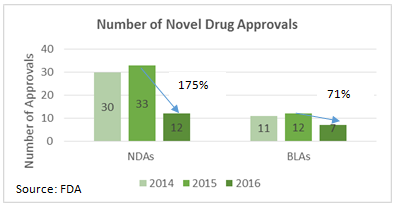
Deconstructing the Decline in 2016 US FDA Approvals with a fine-tooth comb
Following two generously rewarding years of record high number of US FDA approvals with 41 and 45 novel drugs approved in 2014 and 2015, 2016 has been a relatively mellow year, with just 22 new drug approvals. While at face value, this appears to be an alarming hit, there are several angles to consider, and it is important to closely analyze the broader dynamics surrounding drug approval trends in order to make sense of this sudden decrease.

Early Bird Approvals in 2015 and Increasing Trend of Expedited Drug Approvals
There were five early-bird drug approvals in 2015 that had goal dates in 2016 and this is the most common cause attributed for the decline in number of 2016 approvals. While the focus on expediting drug approvals is encouraging, it still does not account for the fall of approvals to almost half of previous year.
The positive growth trajectory of expedited approvals is seen to continue in 2016 as well. At 73%, the record of overall expedited approvals touched a 3 year high in 2016. This increase in number of breakthrough designations and priority reviews is a positive development that signifies the continuance of targeted innovation in the industry.

The timelines for priority approvals are also observed to be fairly consistent, with marginal improvement in 2016 over the past few years. This signifies a positive regulatory focus in accelerating time to market for drugs with significant medical potential and sucha robust regulatory system ensures quicker returns to pharma companies, thereby fostering a ripe innovation ecosystem.
This signifies a positive regulatory focus in accelerating time to market for drugs with significant medical potential and sucha robust regulatory system ensures quicker returns to pharma companies, thereby fostering a ripe innovation ecosystem.
Perpetuating Interest in Pursuit of Rare Diseases
The number of orphan drug approvals is also seen to be on an upward swing in 2016,

in line with the steep growth curve over the past several years, signifying a growinginterest in pursuit of solutions for rare diseases. Considering most rare disease drugs go through a priority review pathway, improving timelines has also served as an impetus to continued industry interest, thus bringing better healthcare output to marginalized patient populations.
Continuance of Robust Biologics Activity
It is also noteworthy that in 2016, many big pharma companies that have had considerable track record of new small molecule approvals in the past few years have stepped aside to allow for higher number of approvals of biologic drugs. Although number of biologics approval has also fallen in 2016, NDAs have fallen by a higher margin and the share of biologics have gone up from 22% in 2015 to 36% in 2016.This stands to prove that industry activity in biologics continue to be robust and is in line with the trend of mAbs and other biologics inching close to 20% of the biopharma market today.

Falling Quality Standards
While the above trends are harbingers of positive industry outcome, another factor that has led to decreased approvals in 2016 and needs to be carefully considered, is the higher number of complete response letters (CRLs) issued by FDA. CDER issued 14 CR letters for novel drugs in 2016, the bulk of which were not issued first cycle approval due to cGMP issues relating to facility and quality. This is alarming in light of the fact that only 4 of the 47 novel drug applications for which a CR was issued from 2010 through 2015 quoted cGMP issues as the primary deficiency. This calls for attention to the burgeoning issue of quality standards in manufacturing that is dampening industry’s current financial health, resulting in thinning of pipeline and also often impacting patients with long and unanticipated spells of drug shortages. The call for action is loud and urgent. It is critical that the industry and regulatory authorities work together to improve the environment of manufacturing quality controls and ensure higher standards of compliance on a regular basis.
Need to Rekindle Small Molecule R&D
While there is an overall fall in number of approvals, the decline in small molecule approvals has been far steeper than the decline in biologics. We note declining interest in pursuing novel small molecule drugs for large indications. This progressive decline in the recent past has also been partly fueled by higher regulatory scrutiny in this category on monitoring cardiovascular outcomes, especially in the case of drugs for metabolic diseases.
This trend of declining small molecule interest combined with the robust biologics pipeline and increasing interest in rare diseases compounds the looming challenge of drug pricing and affordability. Globally, we don’t have a novel funding mechanism for orphan drug discovery or an innovative reimbursement approach to facilitate drug access. The continuing industry focus on large molecules for small indications spells economic and sustainability concerns that are deep rooted. This is vital food for thought and we would like to conclude stressing on the need to take note of the grave implications of this trend. We urgently need to initiate efforts to rekindle interest in pursuit of affordable solutions for large and pervasive health concerns that remain unaddressed.
Authors


Connect with Author at: E-mail healthcare@sathguru.com
 Grow Beyond
Grow Beyond 

